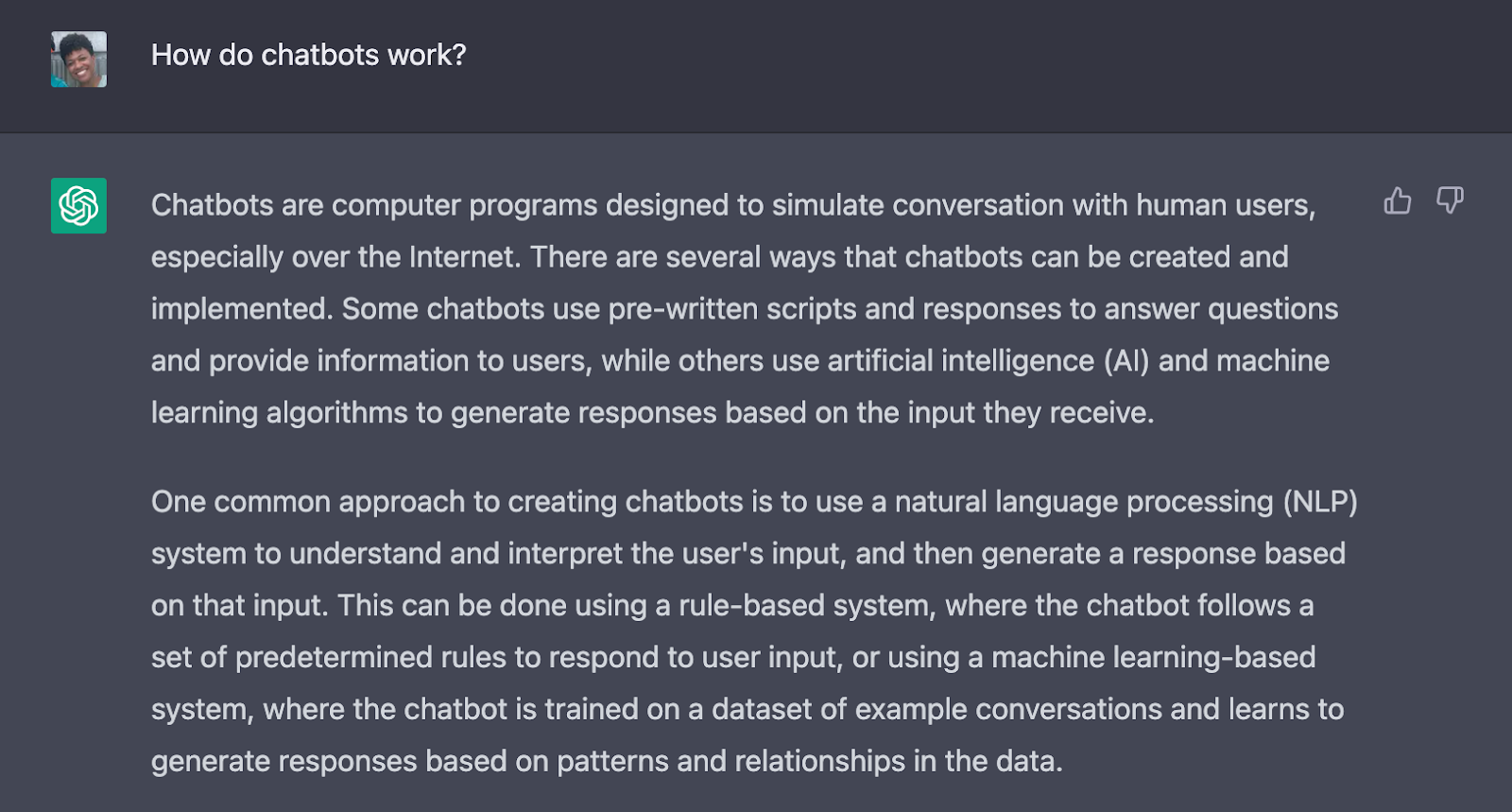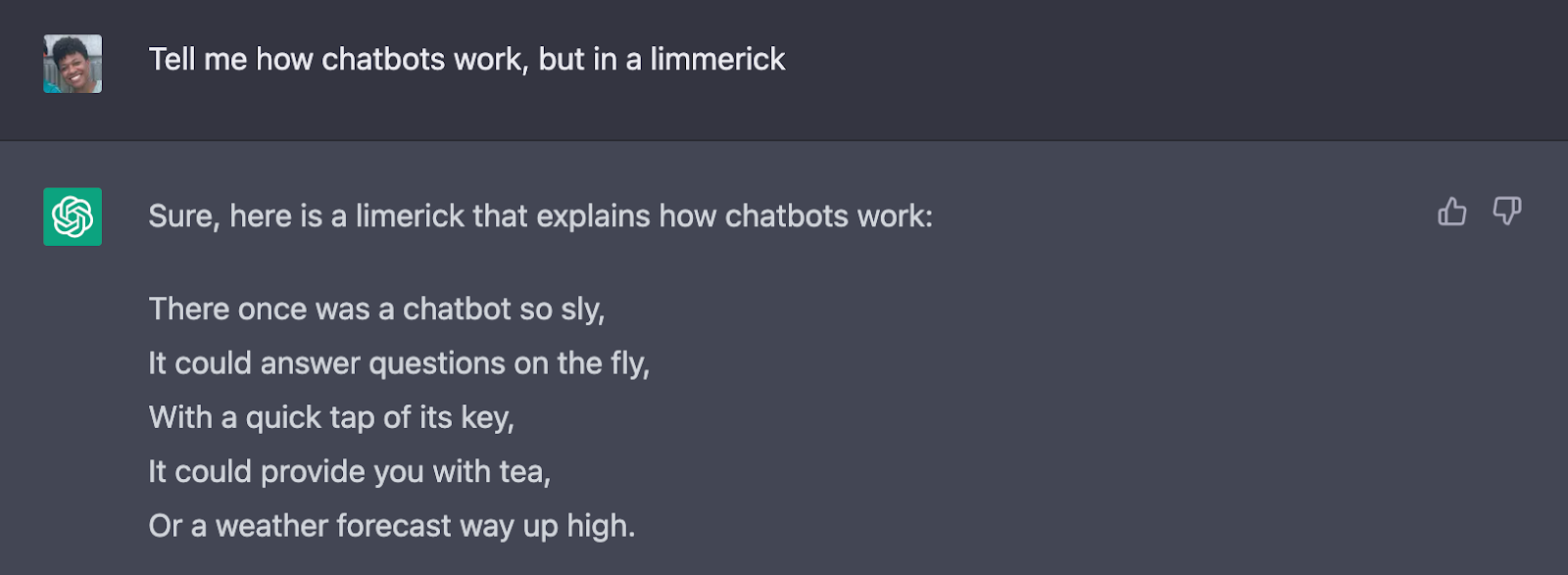A game-changing chatbot, ChatGPT, was released a few weeks ago and it’s already causing a stir. In fact, it gained over a million users in just a few days! So what’s the big deal? ChatGPT uses Artificial Intelligence or AI technology to engage in conversation with users. The chatbot was trained on huge amounts of data and designed to converse in a natural tone, so when you engage with it, you feel like you’re talking to a human and not a computer.
I gave ChatGPT a test run, asking it to tell me more about how chatbots work. This is a snippet of the response:

And just for fun, I asked it to turn the explanation into a limerick! Here’s a sample:

Not only can you ask for the definition of a word, directions for a task, summaries and explanations, you can also get poems, recipes and even lesson plans! Many educators are touting the benefits of a tool like ChatGPT to change the way students work, while others see the challenges it creates.
Using ChatGPT AI in the Classroom
| Benefits | Challenges |
|---|---|
| 1: ChatGPT can provide personalized assistance or tutoring for students who are struggling with concepts. It’s a nice source for ideas and inspiration to give students a place to start. 2: Teacher productivity can be improved as they lean on ChatGPT for lesson plan creation, assessment question design, prompt generation, work examples, and more. 3: Chatbots are adaptable and their use can be modified as needed to meet the changing needs of students and teachers. 4: Teaching students to work WITH new technologies like AI and chatbots, will prepare them for the future of school and work. Teachers can demonstrate appropriate use and ways to leverage the tools for better outcomes. | 1: Some teachers may struggle to prevent inappropriate use of the tool, e.g. using it to complete assignments or assessments. Each response is original and therefore may not be flagged by plagiarism detectors. 2: It’ll be important to build awareness and skills around identifying biased or inaccurate information produced by the chatbot. 3: Schools and districts will need to determine whether to allow or block ChatGPT from their network, and understand that it may still be accessible with personal devices. 4: Support and training should be provided to teachers in order to overcome challenges and find ways to use ChatGPT in positive ways. |
If you’re like me, upon hearing about ChatGPT, you started thinking about all of the amazing ways to use this revolutionary tool in the classroom! Try it for yourself here: https://chat.openai.com/chat
Over the last couple of weeks, I’ve scoured the web, listened in on teacher discussions, and curated a list of 10 ways to use ChatGPT’s powerful technology in the classroom:
Google or Wikipedia alternative
Ask ChatGPT questions as you would in a Google search or call up information that would traditionally be available on Wikipedia. What makes ChatGPT a game changer is that you can ask follow-up questions to clarify your understanding of the topic.
Generate definitions
Not only can you gather definitions in seconds, users can also request that same definition at a specific complexity level. For example, “Explain the period of Reconstruction in the U.S. suitable for a 5th grader.”
Ask for summaries
ChatGPT can quickly summarize concepts, historical events, and pieces of text (including specific chapters or scenes!). Students can then compare and contrast their own summaries or use the chatbot summary to spark discussion.
Collecting examples
Generate examples of written work as inspiration for students before they write. ChatGPT can create essays, poems, arguments, outlines, and more!
Remix writing
With ChatGPT you can create pieces of text (summaries, stories, etc), then remix those same stories into alternative formats. Want to see your short story transformed into a nursery rhyme? Or your persuasive essay converted to a rap battle? No problem! ChatGPT can do that in just seconds!
Edit and improve writing
Use the chatbot for quick feedback! Students can paste a piece of writing into ChatGPT and request edits and revisions, including fixing grammatical errors, adding transitional phrases, higher level vocabulary, and even quotes or facts to back up claims. Students can then reflect on the changes suggested and use the feedback to improve future writing.
Weave it into your routines
Need a great morning joke? Want to know the weather for the week? Would you like help crafting an email or parent newsletter? ChatGPT can be your classroom assistant. You can also teach students to use it as part of classroom routines like “Think, Pair, ChatGPT, Pair, Share” where they consult with the chatbot as they collaborate on a topic and build the habit of evaluating and critiquing chatbot output.
Generate prompts and questions
Need help creating a writing prompt or questions for an assessment? Let ChatGPT help! It can even generate examples from a specific piece of writing or idea. Save time by using technology to your advantage. Remix the prompts and questions into your own words, then add to your favorite quiz app or build into an LMS assignment.
Create lesson plans
Another great way to use ChatGPT is to build lesson plans. Input your objectives as well as other parameters, then use the output as a starting point for your lesson plans or curriculum development.
Teach digital citizenship
Perhaps the most important consideration when thinking about the use of ChatGPT in the classroom is the teaching of appropriate use. As technology advances and AI becomes a usable classroom tool, it’s imperative that we teach students how to use it. Build in lessons to evaluate and discuss ChatGPT outputs.
Now that your interest has been piqued and you’ve seen some of the great ways this tool can transform your classroom, dig into the additional resources below and find new ideas and inspiration for using AI in the classroom!
- “No, Artificial Intelligence Won’t Destroy High School English (Or Any Other Subject),” by John Spencer
- “An AI Wrote this Blog Post,” by Eric Curts
- “Navigating ChatGPT, Chatbots, and Artificial Intelligence in Education (Panel Discussion),” from Ditch that Textbook
- “20 ways ChatGPT can help you teach/learn,” a Twitter thread from Matt Miller
- Explore what’s possible with some ChatGPT example applications







